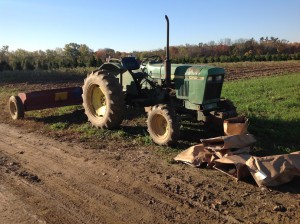- Dickeya sp., an aggressive form of Black leg, has been confirmed on potato in New Jersey.
Symptoms of Dickeya infection look similar to Black leg infection and can cause significant rot above ground (stems and foliage) and below ground (tubers). Very little information is available on Dickeya, since it is most likely a new pathogen on potato to the US. It has also been found in Europe in recent years. - Bacterial leaf spot race 6 was confirmed on bell pepper near Vineland this past week. All bell and non-bell pepper varieties currently grown in New Jersey lack resistance to this race of the pathogen.
All pepper growers need to scout on a regular basis and know what BLS resistance packages the varieties they grow carry. Bell pepper varieties such as Tomcat and 1819 carry resistance to races 1 to 5. Thus, if symptoms of BLS appear on either variety then race 6 is most likely present on the farm and any pepper that lacks resistance to race 6 has the potential to become infected.
Vegetable Crops Edition
Seasonal updates and alerts on insects, diseases, and weeds impacting vegetable crops. New Jersey Commercial Vegetable Production Recommendations updates between annual publication issues are included.
Subscriptions are available via EMAIL and RSS.
Quick Links:
 NJ Commercial Vegetable Production Recommendations
NJ Commercial Vegetable Production Recommendations
 Rutgers Weather Forecasting - Meteorological Information important to commercial agriculture.
Rutgers Weather Forecasting - Meteorological Information important to commercial agriculture.
Two Important Vegetable Production Pathogens Confirmed in NJ
Vegetable Disease Briefs – 8/11/15
- Bacterial leaf spot race 6 has been confirmed on bell pepper in the Vineland area. This has major implications since all widely-grown peppers (bell and non-bell) in New Jersey do not have resistance to this race. All bell peppers growers need to scout on a regular basis and know what BLS resistance packages are present in the varieties they are growing.
- There have been no new reports of late blight in New Jersey since 7/8 although it has been reported in other States in the region. To track late blight in the US please visit http://usablight.org/
- Cucurbit downy mildew has been reported on cucumber in New Jersey and on cucumber and butternut squash. All cucurbit growers should include downy as well as powdery mildew specific fungicides in their weekly maintenance sprays. To track the progress of CDM in the US please visit http://cdm.ipmpipe.org/.
- Basil downy mildew remains active across the region.
- Pepper anthracnose has been reported.
Audit Ready: Equipment Maintenance Records
 The harmonized audit requires a listing of equipment (2.7.1) that has the potential to come into contact with the crop, and for each piece of equipment a maintenance record.
The harmonized audit requires a listing of equipment (2.7.1) that has the potential to come into contact with the crop, and for each piece of equipment a maintenance record.
Just how detailed of a record do they want?
Anytime there is a repair, cleaning, or fluid change there should be a record of this task. The auditor will look at the equipment for signs that there could be a issue, such as an oil or fluid leak under the equipment. If they see an issue they will then ask to see the maintenance record for that piece of equipment. This falls under the “are in good repair and are not a source of contamination of produce” section of standard 2.7.2. Remember, this is only for equipment that will go out into the field or production area.
Audit Ready: Handling Unwritten Policies
 In both the GAPs and Harmonized audits there are standards that focus on policies, yet the checklist does not indicate that a written policy is required.
In both the GAPs and Harmonized audits there are standards that focus on policies, yet the checklist does not indicate that a written policy is required.
You can choose to not write these policies in your plan but you and your employees need to be prepared to answer questions from the auditor about these policies. Your answer to the auditor needs to be the same as your employees; they will verify this!
If the auditor does not find the policy or the employee answer satisfactory, you will receive a “CAN” (corrective action needed).
Vegetable IPM Quick Update
There has been little change in the corn earworm (CEW) situation over the past week. Very few individuals have been captured north of Camden County.
For silking sweet corn, the following spray schedules are warranted.
Silking Spray Schedules:
South – 3-5 days
Central –4-6 days
North – 6 days
Vegetable Disease Briefs – 8/2/15
- There have been no new reports of late blight in New Jersey since 7/8 although it has been reported in other States in the region. To track late blight in the US please visit http://usablight.org/
- Cucurbit downy mildew has been reported on cucumber in New Jersey and on cucumber and butternut squash. All cucurbit growers should include downy as well as powdery mildew specific fungicides in their weekly maintenance sprays. To track the progress of CDM in the US please visit http://cdm.ipmpipe.org/.
- Bacterial leaf spot is being reported on pepper and tomato. There is evidence that BLS race 6 and/or 10 is present in New Jersey this season. Samples have been submitted for confirmation.
- Basil downy mildew remains active across the region.
